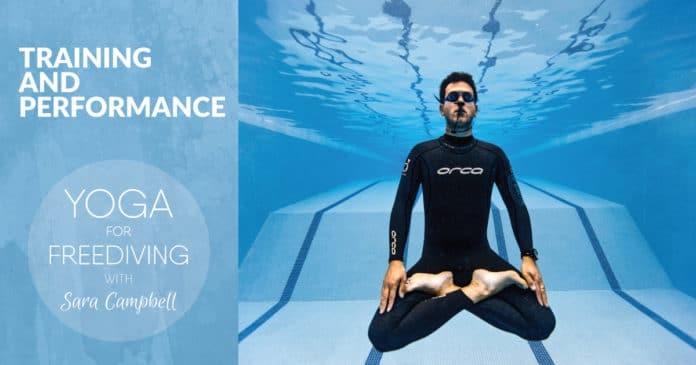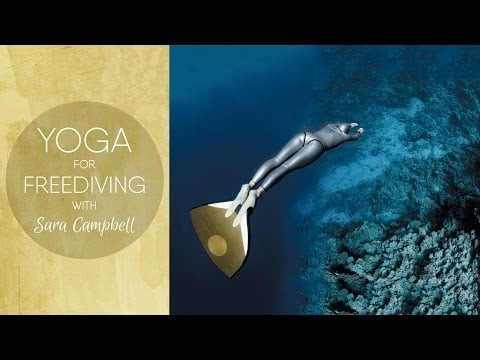“This is what freediving is really about; it is a process of looking inside ourselves and, when we meet the challenges and blocks, we have an opportunity to work through and release them, so we have greater freedom in all areas of our lives.” Sara Campbell
DeeperBlue.com has returned to our continuing series of reviews of Yoga for Freediving, the comprehensive course of study and practice created and designed by Sara Campbell, 4-time Freediving World Record holder. Training and Performance, the fourth of six video series in this “Master Class”, explores the mental and spiritual components of freediving success.
The reviews of the first three series from the Yoga for Freediving course, Deep Relaxation, Manage Your Mind and Energy Beyond Breath, examine the foundation for the student’s meditative practices and journey of discovery. Through the coursework, students learn how to implement Kundalini Yoga techniques to maximize their self-awareness, control of breath and finding the right mindset to maximize performance and focus.
SIGN UP TODAY via www.yogaforfreediving.com
“Kundalini teaches us, through postures (asanas or kriyas), breath-work (pranayama), chanting (mantras), meditation and relaxation, to embrace our wholeness, the fullness of who we each are, and to recognize that at our core, we have pure, peaceful and joyful potential waiting to be explored.” Sara Campbell
Sara Campbell is the founder of Discover Your Depths, “a unique teaching and personal growth philosophy based on yoga, meditation, freediving and mind-body awareness.” She designed the Yoga for Freediving program, which contains six yoga-based freediving courses, each bringing the viewer well over two hours worth of advice, exercises, techniques, and meditations to help you tackle what Sara considers to be the six crucial aspects of freediving as a spiritual journey:
- DEEP RELAXATION
- MANAGE YOUR MIND
- ENERGY BEYOND BREATH
- TRAINING AND PERFORMANCE (This Review)
- SUCCESS AND FAILURE
- PRE-DIVE PREPARATION
With each of the six courses, Sara is including her 22 free Yoga for Freediving ‘How To‘ and ‘About‘ videos. These modules cover the essential techniques and terminology used throughout the program. Each video is a stand-alone training tool and the yoga sections are crucial for helping you create a regular meditation practice. These videos are also being released on Sara’s YouTube Channel – please subscribe to receive the videos and other exciting updates.
Training and Performance is a six-week course that continues the instruction that began in Deep Relaxation, Manage Your Mind and Energy Beyond Breath. If you are just discovering this series of reviews, or are new to the practice of Yoga, we would encourage you to read the previous three reviews on DeeperBlue.com which will provide a primer on yoga as a practice, some of the basic terminology you will encounter in these courses, and background on how Eastern philosophy and meditative practice has become such a large component of so many freedivers’ training regimen.
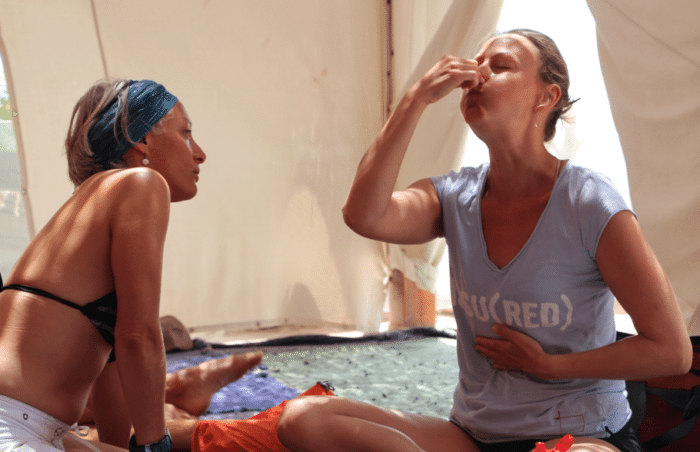
“Yoga was a major part of my everyday routine for the first four years for my freediving career.” Alexey Molchanov
Each course in the series builds on the previous one (though they can be taken as stand-alone courses), providing a comprehensive and detailed training regimen. Training and Performance continue to build on the foundation principles and practices we learned in the earlier courses and includes six separate videos:
- Lecture: Training Zone
- Lecture: Comfort Zone
- Pranayama: Basic Breath Series
- Kriya: Basic Spinal Energizer
- Lecture: Respecting Your Body
- Visualization: The Perfect Dive
We know that one would not tackle a new sport without preparation and warm-up. Sara recommends that each student first watches all six videos to familiarize themselves and become comfortable with the material. If you haven’t already, the student is asked to download the 40-Day Meditation Practice document (the link will be provided to each student) to prepare themselves. This helps guide the student in the start of a daily practice (if you don’t already have one started) and gives easy instructions on how to prepare yourself mentally for the course and for the rest of your day!
By now, if you have been studying the series, you have set up a meditation corner in your home, decorated your altar, bought a yoga mat or meditation cushion, and are keeping a journal to accompany you on this journey. If you are just now discovering Yoga for Freediving, then Sara recommends you watch the “How To‘ and ‘About‘ videos to gain a better understanding of how these amazing yogic techniques work and can help you throughout this course.
“For me freediving is relaxation. There’s no freediving without relaxation, in mind and body. And the best way to reach this point of total relaxation is the correct breathing technique, pranayama, and meditation. It is on this basis that I have always prepared for all my records, and this is the way I teach freediving.” Umberto Pelizzari
Training Zone
The Training Zone is “the very narrow margin between what is challenging and what is sustainable.” For endurance athletes (triathletes, marathon runners, etc.), training zone(s) are benchmarks that combine heart rate, exertion levels, and duration of exercise that reach percentages of 100% effort (competition level performance).
In this 9:15-minute video segment, Sara discusses the differences between what is “challenging” and what is “sustainable” in actual practice. She explains how the challenge may be just getting to the mat to do the yoga exercises or the meditation…and as the student becomes progressively more comfortable with the daily practice, it becomes sustainable. By increasing one’s goal…duration or repetitions…the exercises become increasingly challenging in an incremental manner, building sustainability.
Comfort Zone
The Comfort Zone is “possibly the worst and most dangerous place you could ever be in your life…it’s everything you do habitually.” Sara teaches us that we are “spiritual warriors”, battling against the constructs of our own Ego. If we consider the Ego to be a construct or cage that encompasses us (our Comfort Zone), it becomes clear that this zone is all the things that keep us complacent, keeps us small and confined.
This 11-minute video segment delves into the battle between our spirit and our Ego…that lack of inertia and drive that keeps us from pushing through the artificial constructs and limitations we place on ourselves. Sara describes how “every time you turn early on a deep dive, every time you pop up early in the pool, is the moment you’ve fallen into your comfort zone.” In this video, Sara emphasizes the mindset we should embrace to push through our self-imposed limitations.
Pranayama Basic Breath Series
Pranayama, which is the practice of controlling our breath, lays at the heart of Yoga. In this 45-minute video segment, Sara leads the students through a series of guided breath hold exercises. Building on lectures and instruction from the previous three courses in Yoga for Freediving, this is a rich, practical exercise.
The exercises start with the recitation of “Ong Namo Guru Dev Namo” This mantra is traditionally the first chanted during a session of Kundalini Yoga or meditation. It is referred to as the Tuning Into your Higher Self Mantra and prepares one to start the rhythmic breathing.
“In us, there is a seed of potential…just as the seed needs the perfect conditions to grow, so do we.” Sara Campbell
Sara provides vocal accompaniment and direction throughout the exercise to keep the student “on track”. She begins with a short period of cleansing breaths and moves to the concentrated “Left nostril breathing”.
In Kundalini Yoga practice, Left nostril breathing is designed to activate the Ida Nerve Ending in the left nostril, which relates to relaxation. Left nostril breathing is associated with the moon energy, which is changeable, feminine, yin, giving, and cool. Breathing through the left nostril can calm you and lower your blood pressure.
The student learns new techniques and terms. For example, teaching that your left hand is in Gyan Mudra on your left knee. Close your eyes and concentration at your 3rd Eye (the point between your eyebrows). Begin to breathe long and deep only through your left nostril. Continue for three minutes. Then we repeat the exercise on the right side.
Breathing from the Right side is said to activate the Pingala Nerve Ending in the right nostril, which relates to alertness and activity. Right nostril breathing is linked to the sun energy, which is a constant, masculine, yang, and hot. Breathing through the right nostril can energize yourself and raise your blood pressure.
Along with the alternating nostril breathing, the student is guided through a variety of breathing exercises. As they complete this Pranayama, they should feel a sense of “cleansing” of the Nadi‘s and a free-flowing of vital energy.
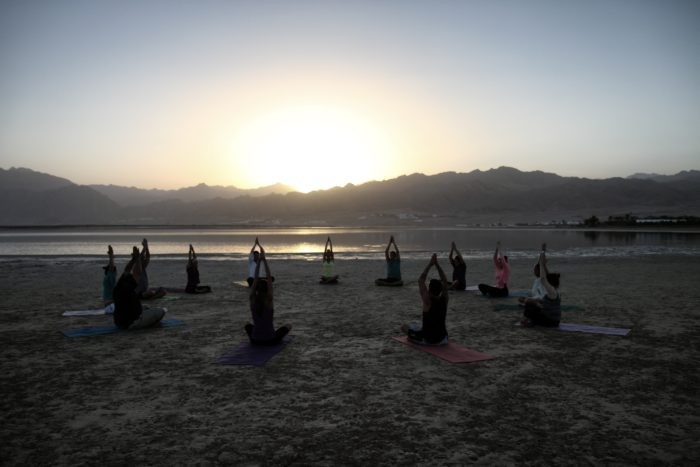
Kriya: Basic Spinal Energizer
In Kundalini Yoga, a kriya refers to a series of postures, breath, and sounds that work toward a specific outcome. Practicing a kriya is key to starting a sequence of physical and mental changes that affect the student’s body, mind, and spirit.
In this 49-minute video segment, Sara explains that by focusing on the spine we concentrate our attention on the core of our strength, our internal communication system and the storehouse of our energy. Through guided exercise, the students are taken through the kriya step-by-step.
The various exercises build on the basic instruction in the Warm-Up series of videos, so students are advised to refresh themselves with this bonus, included material.
Respecting Your Body
In this 11:26-minute video segment, Sara discusses the body and it’s capacity when “we work with harmony in nature“. This course specifically talks about deep freediving and how we must allow our body to work in harmony with the elements. Sara discusses incremental progression and building on previous experiences to set future targets and goals.
When the student gets specific advice from a 4-time World Record holder regarding how to increase their depth, one can be assured that this is based on Sara’s personal experience and real-world training sessions.
Sara shares here thoughts as she shares her own personal story about a time when she set her depth incorrectly, resulting in a dive 10 meters deeper than she intended. The experience Sara had illustrates the protective properties of managing the Mind and relaxing the Body, coupled with regular and specific training.
By “Respecting your Body“, and recognizing the signs and symptoms of squeeze and negative effects from deep diving, you are going to keep within your body’s safe limits. Having the discipline to pace your training and target attainment within the boundaries of what your body is “telling you” will result in safe diving and allow you to continue to train and compete.
Visualization: Perfect Dive
Sara writes “Visualizations are a hugely effective training tool, especially when we recognize that rest is as important as, or even more so than our physical training. While you rest your body goes through its natural adaptation process, and visualizations strengthen this process even further.”
The 20-minute video segment starts with the students thinking about a Free Immersion (FIM) dive to 30 meters. Sara advises the students that if they are not currently reaching a depth of 30 meters in their training, that’s OK; for the purpose of this exercise, we get to come along on that 30-meter dive.
Through “Visualization“, the student trains their mind and the neuromuscular pathways on rest days, giving the mind and the body the experience of a dive without physically doing it. The premise is that the mind and body receives a significant training effect through this exercise without the actual rigors and potential hazards of the deep dive.
As Sara guides the student through the visualization of the dive, the student will learn how to “see and feel” the elements…the equipment, the air, the water, the temperature…preparing the mind and body for future in-water dives.
Visualization has been long recognized by athletes as a powerful tool…you “see” the results you are trying to attain, making it easier to push through barriers when doing it in the “real world”.
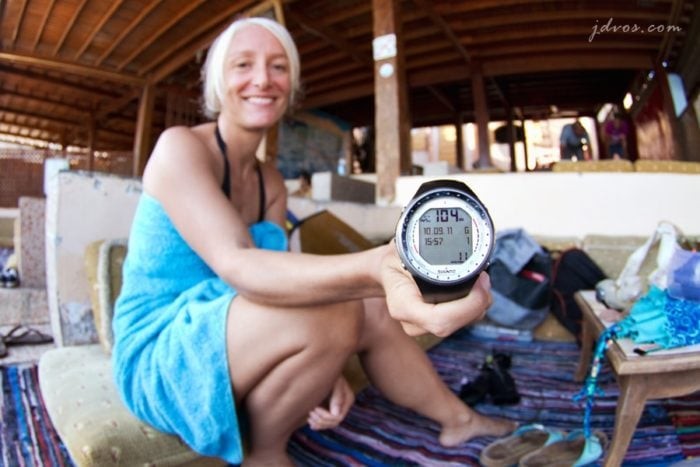
More About This Course
- Features:
- six videos and over two hours of expert targeted Training and Performance exercises
- a further two hours of tips and technique training in 22 HOW TO videos
- video streaming on any mobile device
- MP3 audio downloads of the lectures and visualizations to take with you wherever you want
- step by step program guidelines to ensure you get the best out of your Training and Performance experience
- PRICE: $50 USD
- Available from www.yogaforfreediving.com

